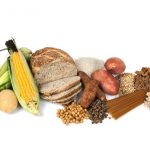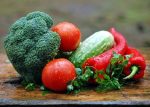
Total fructans is a reference to not only fructans but also inulin and fructo-oligosaccharides (FOS) which are now found in a wide range of human foods, cattle and pet foods. They are an important part of our daily intake of dietary fibre. They are all naturally occurring and found generally in a wide range of vegetables such as chicory, onions, Jerusalem Artichoke, garlic and asparagus.
The benefits of fructans are due to their ability to remain undigested as they pass through the stomach and small intestine until they reach the large intestine, especially the colon. Here, they are metabolised by gut bacteria and so serve a valuable function as prebiotics.
Analysis
Fructans have been difficult to measure and quantify using the standard total dietary fibre methods such as AOAC 985.29 (Total Dietary Fibre in Foods) and 991.43 (Soluble Dietary Fibre in Food and Food Products). A different set of analytical methods are now used based on AOAC methods, 997.08, 999.03 and 2016.14. No one method suits all and most analytical services will advise on a particular set depending on the nature of the product. AOAC methods 997.08 & 999.03 rely on an analysis of the fructan component monosaccharides, glucose and fructose following enzyme hydrolysis. The two methods have limitations due to the strategies used for removing background interferences such as sucrose, α-glucooligosaccharides, and free sugars.
Method 997.08 has a lower LoQ (limit of quantitation). LoQ is the lowest concentration at which the analyte can not only be reliably detected but at which some predefined goals for bias and imprecision are met. Its accuracy suffers from the presence of too much sucrose in a sample. Method 999.03 is less affected by sucrose but its LoQ is higher.
The performance for any new method must generally lie within the requirements outlined in the AOAC Standard Method Performance Requirements (SMPR® 2014.002), which specifies recoveries in the range of 90-110% and RSDr (Robust Standard Deviation of the Residuals) values below 6%.
Analytical researchers have sought to combine the two methods by using the sample preparation steps of AOAC Method 999.03 to remove sucrose and other free sugars combined with the detection method of AOAC Method 997.08 to achieve the low LoQ (Cuany et al., 2010).
This new combined method obtained a new LoQ of 0.13g/100g with powdered products when a 1 gram sample was used and recoveries in the range of 83 to 103% in the presence of sucrose at 12g/100g. The measurement uncertainties was calculated and were +/- 17.4% for oligofructose and fructo-oligosaccharide (FOS) concentrations when around 0.2g/100g to +/- 21.0% for FOS concentrations of 0.6g/100g.
A method has been designed for measuring fructans in infant formula and adult nutritional products which overcomes the limitations of interference. Recoveries are in the range of 86 to 119% (Brunt et al., 2017). RSDr values were in the range of 0.7-2.6%, with one exception when the fructan concentration was close to the LOQ, resulting in an RSDr of 8.9%.
Testing Requirements
If tests are needed on raw materials such as inulin or oligo-fructooligosaccharides then the AOAC 997.08 method is ideal for that level of purity. The issues appear to come with finished products which contain a range of other ingredients that compromise accuracy.
When the formulation contains lots of sugar, starch and maltodextrin, and the overall fructan content is low, then AOAC 999.03 will suffice otherwise AOAC 997.08 is sufficient. The former test has the advantage of being quick and a single chromatographic test is needed. The issue is that there is lower recovery of oligofructoses which produces an underestimation of between 10 and 20% of particular fructo-oligosaccharides.
In recent years, AOAC 2016.14 has been assessed for its efficacy and accuracy (Spichtig et al., 2020). After this study using 14 laboratories in 11 different countries, the AOAC Stakeholder Panel for Infant Formula and Adult Nutritional Expert Review Panel (SPIFAN ERP) concluded that the data presented mostly met the SMPR and hence recommended that the method to be advanced for adoption as an AOAC Final Action method.
The principle of the method for AOAC 2016.14 is summarized by Spichtig et al., (2020) which uses anion-exchange chromatography with pulsed amperometric detection as:-
“Samples are reconstituted in water (if required) and further diluted until the concentration of fructan in solution is such that after hydrolysis the fructose and glucose concentrations will be within the range covered by the standard curve. The diluted sample is treated with a mixture of sucrase and α-glucanases to hydrolyse sucrose and α-glucooligosaccharides to their constituent monosaccharides. The sample is passed through a solid phase extraction (SPE) column packed with graphitized carbon. Salts and monosaccharides pass through and are washed away, while the fructans are retained. Fructans are released from the column using an acetonitrile solution. The released fructans are hydrolyzed with a fructanase mixture, and the released glucose and fructose are analyzed by high-performance anion-exchange chromatography with pulsed amperometric detection (HPAEC-PAD). The fructan content is calculated by summing the glucose and 0.9 × the fructose contents measured. In some matrices, a blank correction may be necessary and can be applied.”
References
Brunt K, Sanders P, Spichtig V, Ernste-Nota V, Sawicka P, Iwanoff K, Van Soest J, Lin PKT, Austin S. (2017) Dual-Laboratory Validation of a Method for the Determination of Fructans in Infant Formula and Adult Nutritionals: First Action 2016.14. J AOAC Int. May 1;100(3):753-767. doi: 10.5740/jaoacint.17-0007. Epub 2017 Mar 7. PMID: 28271820. (Article)
Cuany D, Bénet T, Austin S. (2010) Development and single-laboratory validation of a method for the determination of total fructans in infant formula. J. AOAC Int. Jan-Feb;93(1):202-12. PMID: 20334182. (Article).
Spichtig, V., Austin, S., Brunt K, Van Soest J, Sanders P. (2020) Determination of Fructans in Infant Formula and Adult/Pediatric Nutritional Formula by Anion-Exchange Chromatography with Pulsed Amperometric Detection after Enzymatic Treatment: Collaborative Study, Final Action 2016.14. J AOAC Int. Sep 1;103(5):1301-1317. doi: 10.1093/jaoacint/qsaa064. PMID: 33241403. (Article)


Leave a Reply